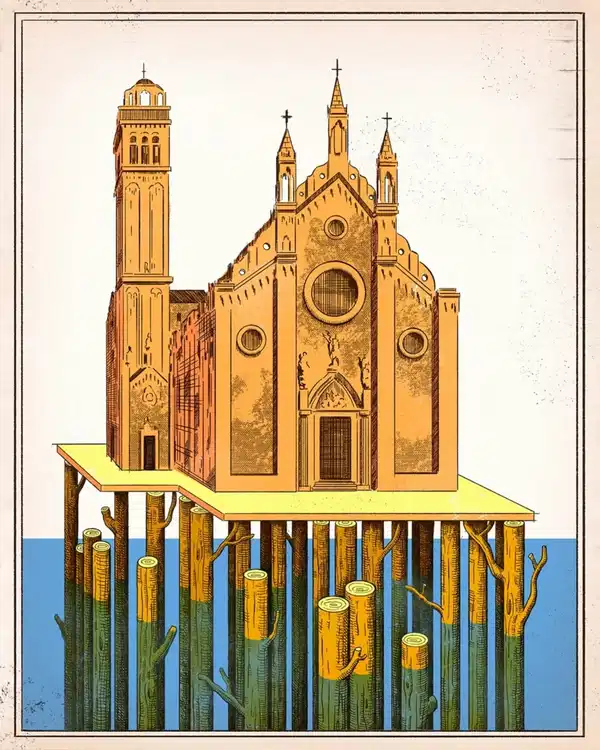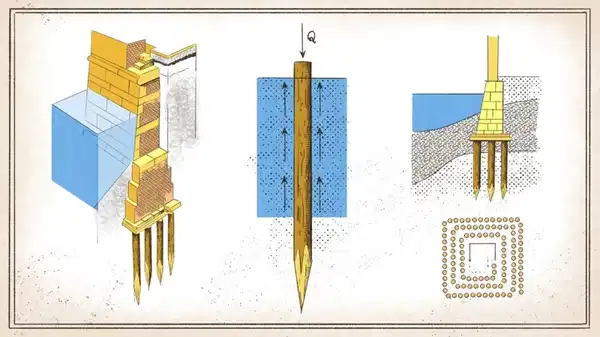The system that kept Venice afloat for 1600 years

Every Venetian knows: the city is a forest upside down.
The 1,604-year-old city is built on millions of short wooden stakes driven into the ground with their tips pointing downwards.
These trees (larch, oak, alder, pine, spruce and elm), varying in height from 3.5 metres to one metre, have been supporting stone palaces and high bell towers for centuries.
It presents a true engineering marvel that harnesses the power of physics and nature.
In most modern structures, reinforced concrete and steel do the job this inverted forest has been doing for centuries.
Despite their strength, few places have endured as long as Venice.
“Concrete or steel piles today are designed to last 50 years,” says Prof. Alexander Puzrin of Geomechanics and Geosystems Engineering at ETH University in Zurich, Switzerland.
“Of course, they can last longer, but when we build residential and industrial structures, the standard lifespan is 50 years,” he adds.
The Venetian pile technique is considered fascinating for its geometry, durability and immense scale.
It's unknown exactly how many millions of piles lie beneath the city, but the foundation of the Rialto Bridge alone contains 14,000 tightly packed wooden poles.
There are 10 thousand oak trees under the Basilica of San Marco, built in 832 AD.
 The people who drove the stakes into the silt were called battipali or pile drivers, and they would sing a song to help them keep the rhythm as they worked.
The people who drove the stakes into the silt were called battipali or pile drivers, and they would sing a song to help them keep the rhythm as they worked.
HOW WAS IT BUILT?
The piles are driven in a spiral pattern, starting from the outer edge of the structure and working their way towards the center of the foundation. There are generally nine piles per square meter, driven as deep as possible.
After the driving process, the pile heads were cut off to obtain a smooth surface below sea level.
On top, wooden structures such as zatteroni (panels) or madieri (beams) were placed crosswise.
Workers would lay the stones of the building on this wooden foundation.
The Republic of Venice quickly protected its forests to provide sufficient wood for construction and ships.
"Venice invented forestry," says Nicola Macchioni, Research Director of the Bioeconomy Institute of Italy's National Research Council, referring to the practice of growing trees.
Venice isn't the only city built on wooden piles, but there are important differences that make it unique.
Amsterdam is another city partially built on wooden piles.
In the city and many other northern European cities, piles reach deep into the rock base, serving as tall columns or the legs of a table.
"If the rock was close to the surface, there was no problem," says Professor Thomas Leslie, an architect at the University of Illinois in the USA, regarding the construction of these foundations.
On the shores of Lake Michigan in the US, where Leslie lives, the rocks are thought to be 30 metres deep.
"It must be hard to find trees that big, right? There were stories in Chicago in the 1880s of people trying to ride one tree trunk over another, and as you can imagine, it didn't work. Eventually, they realized they could use the friction of the soil," he says.
The principle is based on the idea of reinforcing the soil by driving as many piles as possible, significantly increasing the friction between the piles and the soil.
 Piles beneath Venice are eroding due to bacteria attacking the cell walls of wood fibres
Piles beneath Venice are eroding due to bacteria attacking the cell walls of wood fibres
This is technically known as hydrostatic pressure, Leslie says.
According to his information, this means that when many stakes are placed densely in one spot, the soil "grips" the stakes.
Venetian piles actually work this way; they are too short to reach the bedrock and they hold the buildings up through friction.
However, the history of this form of construction goes back even further.
This technique was described by the 1st-century Roman engineer and architect Vitruvius.
The Romans built bridges near water on piles placed underwater.
Sluice gates in China were also constructed with friction piles.
Puzrin notes that the Aztecs used them in Mexico City until the Spanish came and destroyed the ancient city and built Catholic cathedrals in its place:
"The Aztecs were much better at building for their environment than the Spanish. The Spanish later had major problems with this great cathedral [where the ground sank unevenly]."
"And that's one of the failures," says Puzrin, who teaches a course at ETH examining famous geotechnical failures. "The Mexico City cathedral, and Mexico City in general, is like an open-air museum where all the mistakes in laying the foundations are on display."
 Wood, earth and water provide remarkable strength to Venice's foundations
Wood, earth and water provide remarkable strength to Venice's foundations
Even after being submerged for more than 1,500 years, Venice's foundations have proven remarkably durable.
However, they are not completely immune to damage.
A decade ago, a team from the universities of Padua and Venice examined the state of the city's foundations, starting with the bell tower of the Frari Church, built on alder piles in 1440.
The team included experts from diverse disciplines, from forestry to engineering and cultural heritage.
The Frari bell tower has been sinking 1 mm per year since its construction, a total of 60 cm.
Macchioni, who is part of the team that examined the city's foundations, says that bell towers, compared to churches and buildings, carry more weight on a smaller surface.
For this reason, he notes, they sink deeper and faster, "like stiletto heels."
The team found that the wood in all the structures they examined was damaged, but the system of water, mud, and wood held everything together.
They debunked the popular belief that wood beneath the city does not rot because it is in an oxygen-free, or anaerobic, environment.
The bacteria were attacking the wood even in the absence of oxygen.
However, the activity of bacteria is much slower than the activity of fungi and insects, which operate in the presence of oxygen.
On the other hand, the cells emptied by the bacteria fill with water, allowing the wooden stakes to maintain their shape.
"Should we be concerned? Yes and no. But we should still consider continuing this type of research," Izzo says.
Since sampling began 10 years ago, no new samples had been collected due to logistical difficulties.
Macchioni says it is unknown how many more centuries the foundations will last:
"But as long as the environment remains the same, [it will last]. It works because its foundation system is made up of wood, soil, and water.
Soil creates an oxygen-free environment, water contributes to this and maintains the shape of the cells, and wood provides friction.
WOODEN SKYSCRAPERSIn the 19th and 20th centuries, cement began to be used instead of wood in foundation construction.
However, in recent years, the trend of building with wood has been gaining more and more attention.
Among them are wooden skyscrapers.
“It’s a hugely popular material right now, and for good reason,” Leslie says.
Wood is a material that retains carbon rather than releasing it; it is biodegradable and, thanks to its flexibility, is considered one of the most earthquake-resistant materials.
Venice isn't the only city with wooden foundations, but it is "the only city of incredible beauty where friction construction is used en masse and still stands today," Puzrin adds.
"People who didn't study soil mechanics or geotechnical engineering created something that has lasted for so long that we can only dream of."
*The drawings in this article are for artistic purposes only and are not a true representation of the tightly packed wooden pile foundations beneath Venice, devoid of branches.
Cumhuriyet




